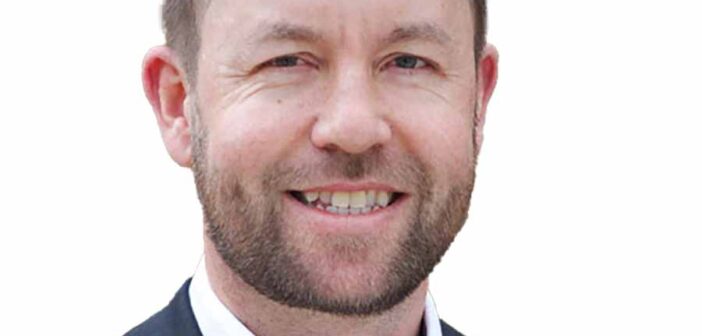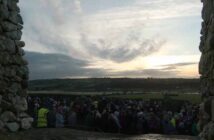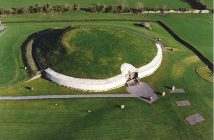The Irish Tourism Industry Confederation conference in Kilkenny saw the first engagement by Minister Peter Burke with the industry. He gave assurances of continued support and a refocus back on food tourism, which had been downgraded under his predecessor.
Speakers expressed fears for the overall messaging being sent form ireland in the competitive international market, the dangers of geopolitics and instability, but overall the speakers own lured the industry was in good financial health.
Opening address from Niall McCarthy
Niall McCarthy opened the Irish Tourism Industry Confederation conference at Lyrath Estate in Kilkenny, addressing over 200 attendees from carriers, accommodation providers, attractions, adventure centres, tour operators and guides.
The conference theme focused on resilience in an uncertain world amid macroeconomic and geopolitical challenges affecting tourism, travel and hospitality.
Tourism contributes €12bn to the Irish economy, including international and domestic markets, and employs 225,000 people as the largest indigenous industry and biggest regional employer.
Government relocated tourism to the Department of Enterprise, Tourism and Employment portfolio, enhancing its economic focus, with Minister Peter Burke attending his first ITIC conference.
Legislative action to lift the 32m passenger cap at Dublin Airport is underway, essential for tourism growth as an island nation, alongside expectations for increased budget investment and competitiveness measures.
Niall McCarthy shared: “Tourism does matter. It’s wonderful to see such a packed room and it’s testament to how important our tourism industry is that we have so many of you here today. We’re pleased at the start of the year when government listened to our calls to move tourism into an economic portfolio and tourism is now better placed in the department of enterprise tourism and employment. It is welcome too that government have acknowledged that a legislative intervention is required to lift the passenger cap at Dublin airport.”
Minister Peter Burke: ‘I’m very different from previous ministers’
Minister Peter Burke revealed the national tourism strategy will be finalised next month after stakeholder engagement, targeting areas of opportunity for sector development.
The strategy includes expanding Fáilte Ireland’s remit to encompass restaurants for resilience building and developing an all-Ireland food strategy to showcase Ireland’s artisan culinary offerings.
Burke aims to re-evaluate corporate plans of state agencies to align with the strategy, improving targets for growth, particularly in lengthening the tourism season into winter periods like Halloween.
New metrics and KPIs will apply to tourism agencies to ensure ambition realisation, with a hands-on ministerial approach expecting results alongside government support.
Focus areas encompass SME model enhancement, market re-entry into Europe and Asia-Pacific regions, and integration with the business events strategy to drive economic value.
Peter Burke shared: “I’m a very different minister than previous ministers. I’m going to take a very hands-on role in the tourism sector I expect results. I want to see Fáilte Ireland’s remit expanded that they will be working with restaurants because that is very much part and parcel with building up resilience in the sector. I also want to see a very strong all Ireland food strategy particularly in the culinary area. I’m very focused on to ensure that all agencies realizse their ambition and realize their targets. We’ll have it finalised next month.”
Luxury booming but budget sector uncertain
A panel discussion on Ireland’s tourism performance featuring Siobhan McManamy (Tourism Ireland), Ruth Andrews (Fáilte Ireland) and Dermot Crowley (Dalata Hotel Group) discussed some of the challenges facing the sector.
Siobhan McManamy revealed North American tourism to Ireland shows a booming luxury market, a stable mid-market and an uncertain budget segment, with mainland Europe offering growth potential.
Dermot Crowley reported flat revenue per available room in 2025 despite rising costs, with Dublin and regional Ireland occupancy slightly down by 1.5pc but room rates up compared to 2019.
Ruth Andrews stressed the importance of policy as an enabler for balanced regional growth, supporting 70pc of tourism jobs in regions through skills, productivity and resilience initiatives.
Infrastructure investments like greenways and blueways, supported by the Just Transition Fund, enhance visitor dispersion and extend tourism seasons, benefiting both domestic and international markets.
The panel addressed pricing perceptions, with Crowley defending dynamic pricing as standard, and McManamy highlighting marketing efforts to position Ireland as an aspirational destination worth the cost.
Siobhan McManamy shared: “The luxury market booming ahead, you know, no slowdown there. We have a clear strategy there now, which will unleash that opportunity for Europe.”
Dermot Crowley shared: “What we’re seeing really is generally speaking a flat revs. Our average room rate for the first six months of the year in Dublin was €153. I think he’ll keep the focus very much on balanced regional growth because that is critical for Irish tourism.”
‘We’re not going to wake up to a massive outflow of investment’
A panel discussion featuring Jim Power (economist), Dan Mulhall (former Ambassador), and Catherine Flanagan (AVEA) discussed the relative financial security of the Irish tourism industry.
Jim Power revealed Ireland’s economy faces risks from over-reliance on US multinationals, with 10 companies contributing 52pc of corporation tax, vulnerable to US policy changes like 100pc pharma tariffs.
Dan Mulhall stressed Ireland’s EU membership as critical for future stability, advocating for a pragmatic foreign policy that balances values and interests amid a shifting global order.
Catherine Flanagan underscored the role of cultural attractions in drawing international visitors, with plans to leverage Ireland’s 2026 EU presidency to showcase unique experiences.
Power expressed concerns over fiscal policy, noting a €1.5bn tax package could be strained by a 9pc VAT rate for hospitality, likely implemented from 1st July 2025.
Flanagan highlighted the visitor attraction sector’s challenges, with a 52pc wage bill and 12pc annual insurance cost increases, despite its small share of tourism revenue.
Jim Power shared: “We’re not going to wake up some morning to discover a massive outflow of investment from Ireland. I’ve always been a fan of the 9pc VAT rate since 2013 and I’ve always argued it should become a permanent part of the cost base for the hospitality sector.”
Dan Mulhall shared: “The whole world is in a terrible chassis. The future for Ireland is clearly as a member of the European Union.”
Catherine Flanagan shared: “Tourism Ireland identifies certain things as the key motivators for people to come here.”
‘The 100,000 welcomes is around 50 to 60,000 now’
Francis Brennan revealed the traditional Irish bed and breakfast, central to the cead míle fáilte, has declined, with only 50-60pc of the famed hospitality remaining due to industry shifts.
Rising costs, including food and coach prices (up from €280,000 to €375,000), challenge the sector, yet Ireland remains a value-for-money destination compared to London’s €1,200 five-star rates.
Brennan noted a revival in boutique-style bed and breakfasts in places like Mitchelstown and Cappoquin, though corporate hotel chains risk diluting the personal touch.
Staff retention, with a 7pc turnover over 15 years at Park Hotel Kenmare, was achieved through team-building initiatives like staff holidays funded by pooled tips.
Brennan advocated for hotel managers to prioritise guest interaction over administrative tasks, citing examples like offering cold towels or chocolate treats to create memorable experiences.
Francis Brennan shared: “The 100,000 welcomes I said I’d say is around 50 to 60,000 now. The personal touch is very important. We are a cheap destination still. The price of food has gone mad. Your business is built on people, your staff, and the guest.”
‘AI will transform healthcare, education, tourism.’
Journalist Mark Little discussed the consequences of the rapid rise of generative AI, impacting industries like tourism in under three years, with potential to transform healthcare, education, and sustainability.
He distinguished hope from optimism, advocating for purpose-driven resilience, inspired by leaders like Václav Havel, to navigate the accelerating pace of global change.
Little highlighted the digitally native generation’s preference for authentic, physical travel experiences, such as thrift shops or cultural sites like St. Patrick’s Cathedral.
He warned of an AI investment bubble, with €100bn investments like Nvidia’s in Open AI potentially outpacing enterprise uptake, risking a dot-com-style crash.
Little urged tourism leaders to prioritise human skills like empathy and decentralised leadership to meet the demands of younger consumers and employees in an AI-driven world.Mark Little shared: “The only constant in our lives has been change. Hope is the axe in the wall that you take off the wall to break down the door to the future that you want to build. The vast majority of those experiments have failed. The competitive advantage for all of us as leaders is to lean into these human skills. Nothing is certain and their next sentence is everything is possible.”
‘Irish industry is in a strong competitive position’
Colin Hunt revealed AIB fully repaid state bailout funds by June 2025, marking the end of a 15-year recovery from the global financial crisis, with the bank now among the best-capitalised globally.
Ireland’s economy has deleveraged significantly since 2007, with a savings ratio of 14pc and reduced debt levels, positioning it strongly amid global uncertainties.
AIB supports the tourism sector with €2.8bn in loans, offering sustainability-linked loans up to €100,000 to promote greener practices and long-term relationships.
Infrastructure deficits, particularly in housing and grid capacity, require a €100bn National Development Plan investment by 2030 to support economic growth and tourism.
Hunt supports the proposed 9pc VAT rate for hospitality, acknowledging the sector’s role in employing 13pc of Ireland’s workforce, with 70pc of jobs outside Dublin.
Colin Hunt shared: “We managed to return the bank to full private ownership in June of this year on Blooms Day. We are amongst the best capitalized and most liquid banks in the world. We’ve got about €2.8bn in loans out to the sector and we want to do more. The Irish industry is actually in a strong competitive position at the moment certainly relative to other. The transition is still happening.”
Impressed with Ireland’s tourist infrastructure
Comedian Timmy Mallet, known for 1980s TV shows, cycled Ireland’s coastline, sharing experiences via viral social media videos, inspired by artist JM Turner’s sketches of Britain and Ireland.
Starting in Belfast, Mallet praised Ireland’s world-class tourism infrastructure, including greenways, and the warm welcome from hotels with handwritten notes, unique to Irish hospitality.
His journey covered regions like Donegal, Sligo and the Wild Atlantic Way, with locals guiding him to attractions like Tory Island and Bundoran for authentic experiences.
Mallet’s visit to Black Sod Lighthouse revealed a personal connection, as his mother verified weather forecasts there for D-Day in 1944, linking his travels to historical narratives.
He plans to return in 2026 to explore the Hidden Heartlands and the River Shannon, encouraging tourism businesses to share unique offerings to enhance visitor experiences.
Timmy Mallet shared: “I am so impressed with the tourism infrastructure here in Ireland it is world class. The infrastructure here is amazing. I get a handwritten message of welcome. Now that’s cheap to give and expensive to receive, but it’s also really unique. There’s a kindness and a generosity which is part of the DNA of Ireland. I’d like to come back and do some of the Hidden Heartlands.”
John Healy of Abbey Tours was presented with the Eileen O’Mara Walsh contribution to the industry award.
‘Impressed with the minister’
Eoghan O’Mara Walsh closed the ITIC conference in Kilkenny, praising the unified approach of diverse tourism businesses in showcasing Ireland to domestic and international audiences.
The minister’s business perspective and commitment to tourism within an economic portfolio were well-received, with optimism for delivering promised measures over multiple budgets.
Recent lobbying successes include legislative intervention to lift the Dublin Airport passenger cap and discussions on reducing the hospitality VAT rate to 9pc.
The tourism sector, as Ireland’s largest indigenous industry and biggest regional employer, benefits from strong support by Fáilte Ireland, Tourism Ireland and AIB.
Eoghan O’Mara Walsh shared: “It’s been a great day. I was very impressed by the minister. It has long campaigned for tourism to be moved to an economics portfolio and I think you can already start seeing the benefits of that. Lobbying and casemaking is a journey it’s not a destination. We’re the largest indigenous industry, the biggest regional employer.”
Regions suffer in mixed year for tourism
Stakeholders revealed a mixed 2025 for Irish tourism, with a strong North American market but softer demand from domestic, English, and European visitors, particularly impacting regional businesses.
Rising costs, including a 52pc wage bill for visitor attractions and increased insurance, squeeze margins, with businesses unable to pass costs to customers. The 9pc VAT rate reduction, targeted for July 2026, is seen as critical to maintain competitiveness and stabilise ticket prices for tourism enterprises.
Investment in transport infrastructure and connectivity, particularly removing the Dublin Airport passenger cap, is essential to drive regional footfall and growth. The 2027 Ryder Cup and events like the Aer Lingus College Football Classic, attracting 28,000 visitors, underscore tourism’s €0.29 per euro contribution to the exchequer.
Aileesh Carew shared: “2025 has been a mixed year for Irish tourism.”
Elaina Fitzgerald Kane shared: “Costs of business have really escalated.”
Paul Keeley shared: “We would love to see the VAT come down and the 9pc VAT would enable us at very least to hold our ticket prices.”
Aidan Cummins shared: “Economic consultants estimate that 29 cent of every euro spent by a tourist whether they be a domestic tourist or an international visitor goes right back to the exchequer.”
Eoghan O’Mara Walsh shared: “There’s a danger that we’re becoming overconcentrated or overdependent on the North American market.”




